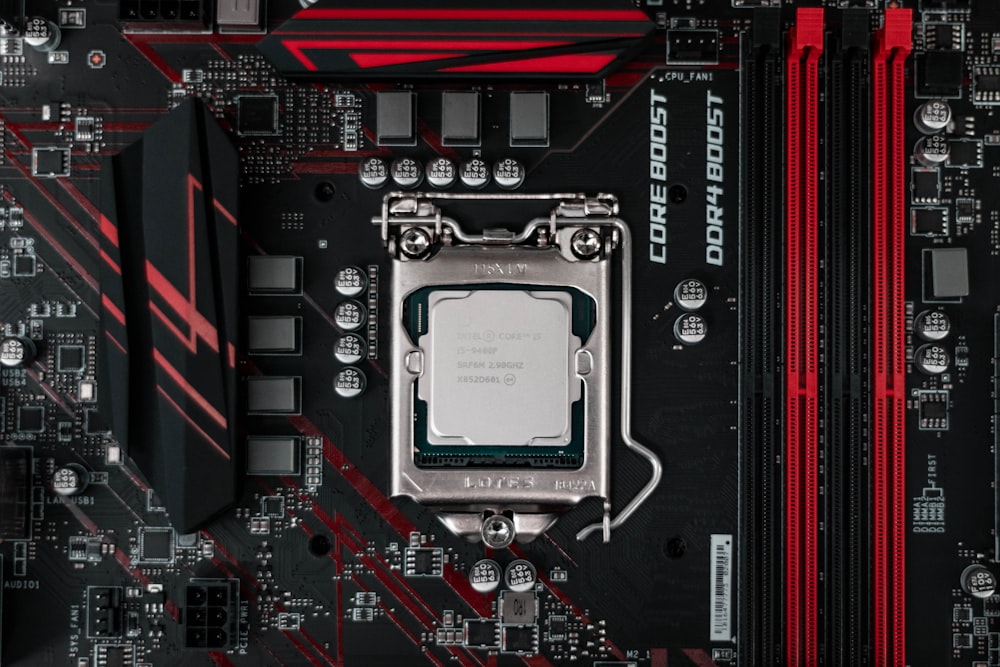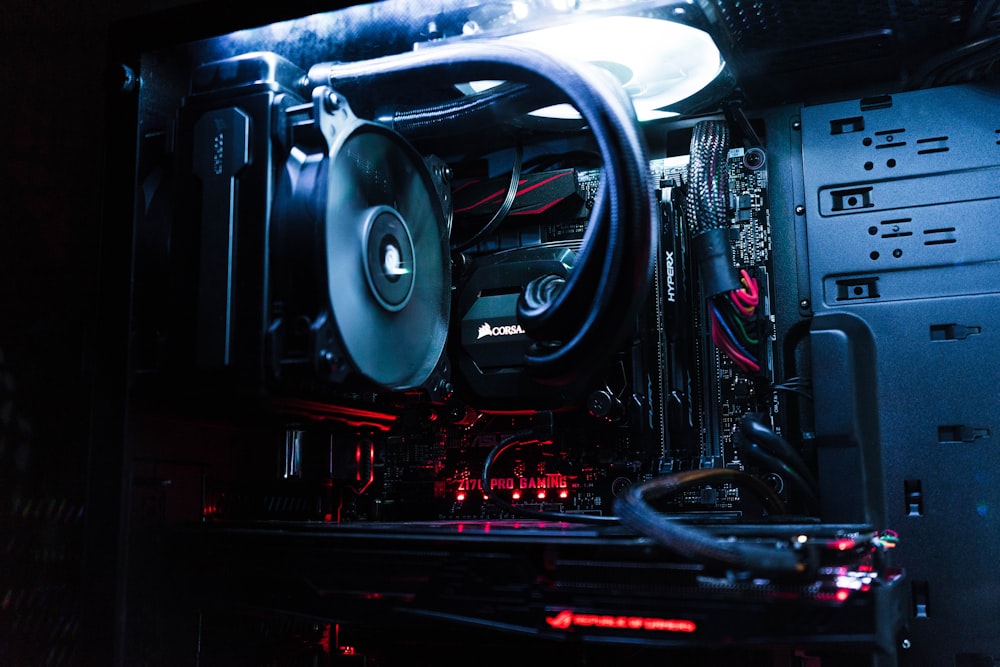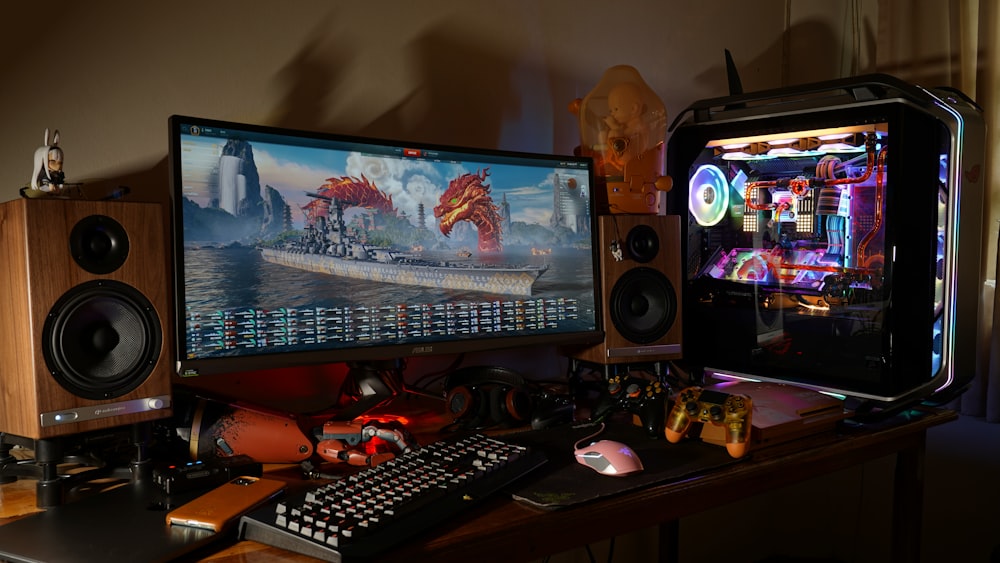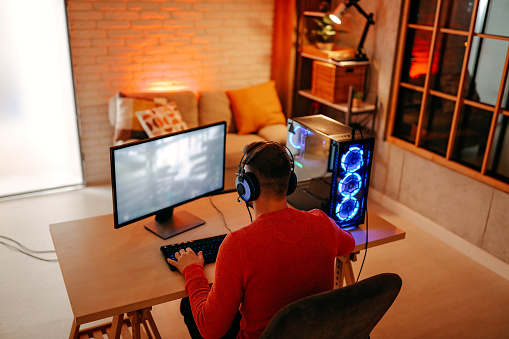It’s no secret that gamers love to travel. In fact, many of us feel happiest when we’re away from home, exploring other countries and cultures while testing our mettle with new challenges. Can You Fly With a Gaming PC?
Yes, you can bring a PC on a plane. TSA states that you can bring your PC on a plane in both your carry-on and your checked-in luggage.
Great destinations for traveling gamers include national parks and remote towns where the cost of living is low.
Add in the magic of VR and you have an unbeatable combination—but how do you keep your gaming rig intact on a plane?
We answer that question and more in this blog post about taking your gaming PC on a plane. There are many things to consider before hitting the airport as a gamer with your own computer.

Related Article: Can You Travel with a Gaming PC?
What’s the Best Travel Case for a Gaming PC?
The best option for transporting a PC is a hard-sided case. This might seem like the most obvious answer, but there are a lot of cases out there.
The best one will have a shock-absorbent foam to protect your equipment and a TSA-approved lock to prevent tampering.
It’s important that this case be durable enough to survive multiple flights, as well as being lightweight so it can be easily carried on board.
Once you find the perfect travel case, all you need to do is pack it with your PC and any other peripherals you want to bring along for the trip.
Be sure to always keep it near you during the flight, though; if it’s checked and gets lost or damaged, they will not reimburse you for any of your losses.
The best travel case for a gaming PC depends on what you need to take on the plane and how much space you have in your luggage.
A good travel case will protect your computer, power cord, mouse, and other accessories from damage. There are a few different styles of cases out there but the two most popular cases are laptop bags and roller bags.
A roller bag can be bulky if you’re only carrying one machine; however, it provides excellent protection for the laptop.
Plus, it has the added benefits of wheels for easy transport and additional storage space for peripherals like mice and cables.
If you do decide to go with a roller bag, we recommend getting a backpack that’s designed specifically for laptops to carry things like clothes or personal items as well as your gaming computer.
The laptop compartment should be padded to provide extra protection. A laptop bag is also an option but it doesn’t provide protection for your computer quite as well as a roller bag does because it doesn’t have wheels or padding.
However, it does offer convenience with its ability to be carried by hand or over the shoulder (depending on size). A backpack-style would still offer some small levels of protection while providing more comfort than just wearing it on your back.
How to Safely Fly With a Computer
The first thing you need to do when flying with your gaming PC takes precautions.
Some simple things to do before you fly are ensuring that the weight of your bag is under 50 pounds, using a hard case rather than a soft case, and packing delicate or breakable items in your carry-on.
Next, you’ll want to remove any cords from inside the computer so they don’t get caught on anything during the flight.
You’ll also want to have plenty of space in your check-in suitcase for any padding needed. Regardless of where you’re going, it’s always best to overpack for just in case scenarios.
If your destination requires more than two power outlets, then a surge protector will be necessary for all but one PC.
You should also get a plug adapter if you’re going abroad as well as some spare cables to charge devices that may not be compatible with international plugs (like Apple products).
This way, if there is an issue with the power supply at your destination, you can still charge your devices while there.
Lastly, remember to bring the actual computer! It’s important that you take enough time off work before flying to make sure everything works properly upon arrival and that any issues can be resolved quickly.
There are many things to consider before hitting the airport with your own computer, and they’re not always easy.
However, it is possible to fly with your computer if you follow these tips: – Pack your computer in an anti-static bag or a hard case that provides some cushioning.
If you use a heavy-duty case, make sure to remove any interior lining to prevent damage to the computer. – Don’t pack anything around the outside of the case; this can lead to scratches and other cosmetic damage.
Put the computer in a part of your luggage where it won’t come into contact with other items such as metal zippers.
Airports typically have lockers for storing larger items like laptops and gaming computers. If available, try using one of these lockers when going through security so that agents can inspect your belongings without damaging them.

The Best Bluetooth Headsets for Travel
By now, most people know that you can’t bring your laptop on a plane. Unless you’re flying in first or business class, or have the airline’s permission, your laptop will be checked-in baggage.
If you’re checking your computer into baggage and want to keep it safe, it’s worth investing in a laptop bag with a built-in lock and tracking system.
But what if you want to play games on a flight? For this situation, we recommend traveling with a gaming console or an iPad.
However, if you need to bring your own PC for some reason and don’t want to risk breaking it during the flight, there are some things you can do to make sure it survives the journey intact.
Many people worry about what will happen to their electronic devices when they fly. The fear is understandable.
You’ve heard stories of laptops being damaged by pressure and jostling around in the cargo area, or worse, your games console exploding from the heat build-up in the cabin.
But there are some steps you can take to make sure your gaming rig survives a flight in decent condition: 1) Make sure you buy a sturdy laptop bag that protects against bumps and shocks.
2) Keep your laptop on the outside of your backpack so it has room to breathe during transit – this is especially important if you’re checking luggage for your trip.
3) Make sure all cables are wrapped up and secured firmly inside your bag – otherwise they could get tangled with other items during transit and risk damage.
4) Pack any valuable accessories separately so they don’t get lost on the way.

Which Type of Computer is Best for Travel?
When you travel, size and weight are especially important. If your PC is too big or heavy, you’ll have to pay extra fees for excess baggage or have it stored in the cargo hold of the plane.
If your computer is too small, it won’t have enough power to run games—let alone VR! A gaming laptop is a good option for those who want a lightweight but powerful machine.
Gaming laptops often come with slim cases and slimmed down components, which means they’re portable and can handle any game, even VR-intensive games like Elite Dangerous.
Another great option for travelers is a gaming tablet. These devices are lightweight with long battery life, so they’re perfect for long flights.
Plus, because they don’t require a keyboard or mouse, there’s no need to worry about losing them on the trip!
If you’re not sure what type of PC will work best for your travel needs, talk to an expert at one of our stores before you purchase anything. We know all about what will work best for gamers on the go!
There are many different types of computers you can buy, and it’s not always easy to know when a laptop is the best choice.
When you’re traveling for business or leisure and need access to your computer at any time, a laptop is the best option. If you want to use your gaming PC on the go, but don’t need constant access to it, a desktop computer will work more efficiently.
Desktop computers have more power than laptops, making them ideal for playing games that require additional graphics and processing power.
Laptops require longer periods of time to boot up and shut down because they have more software features built into their operating system.
However, laptops typically have better battery life than desktops. If you want to take your gaming rig on the plane with you on a regular basis, then investing in an ultra-lightweight laptop might be the way to go.
Low cost/high durability are important considerations when buying a new laptop for travel purposes.
Which Games Are Best On A Plane?
Some games are better played from the comfort of your bed or couch. You’ll want to check with your airline before you try to bring a game on board, in case it is against their rules and regulations.
Most people think that their favorite first-person shooter, strategy game, or puzzle game is the best choice for playing on a plane.
Of course, there’s no one genre that stands out as the best. It all depends on your personal preference and what you’re most excited about playing.
With that in mind, here are some of the most popular games to play on planes: – First Person Shooters – Strategy Games – Puzzle Games – Role Playing Games (RPG)
Which Planes Allow You To Bring Your Own Computer?
Airlines are notoriously strict about what you can bring on board, and laptops are usually prohibited. Couple this with the usual restrictions for liquids and potentially hazardous electrical items, and you have a recipe for disaster.
Luckily, some airlines do allow you to carry your laptop onto the plane; typically those that offer in-flight WiFi or provide entertainment systems for passengers to use.
Some international carriers also allow passengers to carry their laptops with them; check before your travel date to make sure.
Although most major airlines allow you to bring your own computer, there are some restrictions. For example, United Airlines has a 14-inch screen restriction on all devices that are not laptops.
This is a problem for gamers with 17-inch screens, but it’s not insurmountable. You just need to be aware of the size of your screen and make sure it’s less than 14 inches before heading to the airport.
Some other rules include: * All devices must fit into a single carry-on bag that fits in the overhead bin * Devices must turn off when onboard
The battery must stay charged within limits * Your device can’t emit light or have moving parts that may harm others
How To Protect Your Computer During Travel
It’s important to be prepared with your computer when you’re traveling. You want to make sure it’s in a secure place, so it doesn’t get damaged or lost.
There’s a lot to think about, but the best way is to take these five steps: – Pack your cables in a plastic bag or pouch
Put your power brick and cord away from other electronics
Keep the battery charged and ready for use
Use an external hard drive for large files – If flying, put your laptop in its own case. Don’t check it!
1) Pack Your Cables: You’ll need all the cords you need for charging, audio and video connections. Keep them in a plastic bag or pouch to avoid tangling.
2) Put Your Power Brick And Cord Away From Other Electronics: It’s not enough to just keep the cable in a bag – you also want to store the power brick and cord out of reach of other devices.
3) Keep The Battery Charged And Ready For Use: Turning off your computer can help save battery life if you’ll be traveling for more than three hours at a time.
4) Use An External Hard Drive For Large Files: Your computer’s hard drive is small, so if you need access to larger files while on the go, keep them on an external hard drive that plugs right into your USB port. 5) If Flying, Put Your Laptop In Its Own Case – Don’t

Best way to take PC on Airplane?
The best way to take your gaming PC on an airplane is with a laptop case. This will protect your computer from being jostled around and make it easy for you to work in the air.
This is also important if you’re using VR equipment as it’s easy to forget that it may not be protected like your computer.
If you don’t have a laptop case (or are traveling with something other than a laptop), make sure to get a hard-shell luggage case or buy one at the airport.
You’ll want the hard-shell luggage case since this will protect your PC from bumps and jolts–even if you’re checking your bag.
It can also help protect your belongings from theft; generally, these cases are locked, so no one has access to them but you.
Check whether there’s a maximum size for carry-ons when you’re flying. If there is, then consider buying two smaller rolling cases for your PC and VR equipment, which can be checked separately–but remember to keep them together!
If you’re carrying your own bag on the plane, be mindful of how much weight it has before checking in!
Which Gaming PCs Can Fly?
There are a few requirements your gaming PC needs to meet before you can confidently take it on the plane. If your rig is a small form factor, then you might be able to fly with it as long as it meets the size requirements for carry-on luggage.
You should also be sure that your machine has no liquid cooling system in place, as some airlines don’t allow these liquids in checked baggage or on board.
Also, if you’re bringing any accessories that are connected to the computer (like a mouse), make sure they’re not blocking any ventilation points.
Finally, if you have an international flight, you need to check with both the airline and airport to see what additional requirements they might have before boarding.
If you have a desktop PC, then you’ll need to find out what kind of power supply it takes before making any plans—most airlines require passengers to bring their own power cables onboard.
Depending on how much gear is attached to the back of your rig (such as graphics cards), this requirement could make travel difficult or even impossible.

Is Traveling with a PC a Good or bad idea?
The first thing to consider is the weight. The TSA restricts all baggage to 50 pounds, which, with your clothes and other items, might not be a problem.
But if you’re traveling with a full gaming rig, that extra weight could cost you more in airfare. Airlines charge based on weight as well as the number of bags you have.
Another thing to think about is what airport you’re flying out of and what airport you’re flying into. If your destination airport has fees for checking bags, it might make more sense to fly with a laptop or tablet if possible.
Finally, think about how much space you need when it comes to your PC setup. You’ll want enough room for your mouse (unless you just use an Xbox controller or something else) and some space for your keyboard.
It’s best not to plan on using the touchpad on a laptop since it can be difficult to type out lengthy messages without looking down at the keyboard every few seconds.
A desk designed for gaming will also give you plenty of room for upgrades and changes that might come up during gameplay–just remember that this is another big item that could add weight and cost to your travel plans!
Conclusion
Can you fly with a gaming PC? Many people like to take their gaming PC with them when they fly. Checking a bag can be expensive and it’s also a hassle to check-in at the airport.
So what’s the best travel case for a gaming PC? Whether you’re traveling domestically or internationally, the best options are ones that are TSA-approved and which are small enough to fit in your carry-on bag or under your seat in the cabin.
If you’re flying for an hour or a day, you might not need to change the settings of your computer as long as you save your work before you leave and don’t download anything new while you’re gone.
But if you’re traveling internationally and spending more than 12 hours in the air, it’s a good idea to change your computer’s time zone settings before you leave so that it adjusts when you arrive.
If you have some games that you want to play on the plane, bring a laptop instead of a desktop. The best way to take your PC on an airplane? Although it might sound like a fun idea, it’s better to wait until
FAQS
Can you fly with a gaming PC?
Yes, you can. You can fly with your gaming PC, but it’s not recommended. Airlines are only allowed to carry one item that exceeds airplane safety regulations and these rules were created before the “gaming-on-the-go” phenomenon. You can try emailing different airlines to find out their specific policies, but some will say it’s not safe to do so. Others might allow you to carry it on the plane if it fits in the overhead bin or under a seat.
What are the best ways to protect your gaming PC while flying?
The first method is to pack it in a sturdy case and place it in your checked luggage. The second option is to purchase an expensive hardshell case that will be easy to spot at baggage claim. This case will also protect your PC on the way back home again, should you need it.
How should I pack my gaming PC for travel?
To keep your rig intact during travel, you should first place your computer in a protective case and then cover everything in bubble wrap and towels. Place this bundle inside another suitcase or bag to protect from bumps from other items inside the aircraft cabin.
What about my peripherals?
Many gamers take their peripherals like keyboards and mice with them when they fly because these parts are easier to replace than the complete computer itself. Make sure you have an adapter for these items so they work with the airport’s power sockets.
